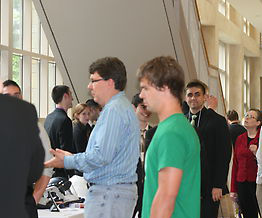About 70 engineering students showcased projects that they’ve been working on since October 2011 at the Senior Design Clinic Friday, May 11.
Eleven companies and nonprofits, such as SoniQ, Emerson, and 3M, inspired students by giving them general ideas with sets of requirements for the projects. St. Thomas engineering faculty then matched students to specific projects based on their preferences, and the students took on the work from there.
Dean of Engineering Don Weinkauf explained that, “the teams will all tell you that at times, it got tough, and they themselves weren’t sure how it was all going to unfold.”
However, Weinkauf said he believes that is exactly what the department is trying to capture in the clinic.
“Where the comforts of well-defined textbook problems are abandoned, real engineering emerges. What you see here today is the manifestation of that uncertain process of translating ideas into reality,” Weinkauf said.
At the clinic, prototypes came in different sizes. Some could easily fit in the palm of one’s hand, while others were too big to be showcased in the clinic. Senior Ann Motl said her team’s project is “almost 10 feet by 10 feet. You have to go downstairs to see it.”
Motl’s group, which included seniors Sam Literski, Perry Jagger, and Jesse Behning, had a project that addressed emerging concerns of the oil and gas industry organization engaged in well drilling and hydraulic fracturing operations.
For seniors Brianna Peters, Katelyn Olson, and Matthew Nelson, their project involved prosthetics and orthotics company Valley Orthopedic Inc. The group developed a cutting edge technology that will allow a surgeon to remove hip implants in less time with more precision and far more desirable results.
“It (the prototype) basically acts as a mini saw that oscillates back and forth,” Olson described.
The teams must research an extensive amount before building their prototypes. They present their findings at the preliminary design review where they are subject to criticism from their clinic advisers. Based on the feedback they receive, they perform more research that they present at the critical design review about two months later.
Another group worked with limited liability company Xollai. The company was founded by a group of engineering and physics students from St. Thomas in 2008.
Seniors Julie Olson, Blake Shamla, Ilya Natarius, Tyler Nesvik, Angela Pechacek, and Ian Mazeika created a gimbaled camera system for Xollai. The system is able to control the movements of a camera in both pan and tilt, relative to the plane, with a slew rate of more than 130 degrees per second.
Natarius said he and his team put forth a great deal of time and effort into making this project a success, but watching everything come together made it all worthwhile.
“Being able to see our idea manifest itself into a working prototype was the best part,” Natarius said.
Geena Maharaj can be reached at maha8007@stthomas.edu.

